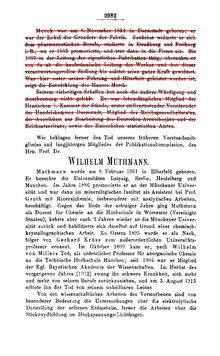Wilhelm Muthmann (chemist)
Wilhelm Muthmann (born February 8, 1861 in Elberfeld , † August 3, 1913 in Munich ) was a German chemist ( inorganic chemistry ).
Life
His father Wilhelm Muthmann was a city councilor in Elberfeld and from 1895 factory owner of the C. Blumhardt vehicle works in Vohwinkel .
Muthmann studied chemistry in Leipzig, Berlin and at the University of Heidelberg (with Robert Bunsen ) and was from 1884 on chemical state laboratory in Munich, where he 1886 at Clemens Zimmermann (1856-1885) with the working lower About oxides of molybdenum doctorate was. He then taught briefly in Boston before becoming assistant to Paul Heinrich von Groth at the Institute for Mineralogy at the University of Munich in 1888 , where he completed his habilitation in 1894 ( contributions to the volume theory of crystallized bodies ). In 1895 he became an associate professor and in 1899 a full professor of inorganic and physical chemistry at the Technical University of Munich, succeeding Wilhelm von Miller .
He dealt in particular with rare earth metals (especially cerites ), their pure representation, their salts, physical and spectroscopic properties. He also hoped to discover a new element, but was unsuccessful.
His work from 1903 on nitrogen oxidation in the electric arc was important for the development of the air combustion process of nitric acid synthesis (later realized in the Birkeland-Eyde process by Kristian Birkeland in Scandinavia).
Muthmann's liquid ( 1,1,2,2-tetrabromoethane ) for the separation of heavy minerals is named after him.
In 1903 he became an extraordinary and in 1909 a full member of the Bavarian Academy of Sciences.
literature
- Claus Priesner: Muthmann, Wilhelm. In: New German Biography (NDB). Volume 18, Duncker & Humblot, Berlin 1997, ISBN 3-428-00199-0 , pp. 654 f. ( Digitized version ).
Web links
Individual evidence
- ↑ Life data, publications and academic family tree of Friedrich Wilhelm Muthmann at academictree.org, accessed on January 4, 2019.
- ↑ Published in Zeitschrift für Krystallographie und Mineralogie, Volume 22, 1894, 497–551
- ↑ On a heavy liquid suitable for separating mineral mixtures, Z. für Krystallographie und Mineralogie, Volume 30, 1899, 73-74
| personal data | |
|---|---|
| SURNAME | Muthmann, Wilhelm |
| BRIEF DESCRIPTION | German chemist (inorganic chemistry) |
| DATE OF BIRTH | February 8, 1861 |
| PLACE OF BIRTH | Elberfeld |
| DATE OF DEATH | August 3, 1913 |
| Place of death | Munich |

